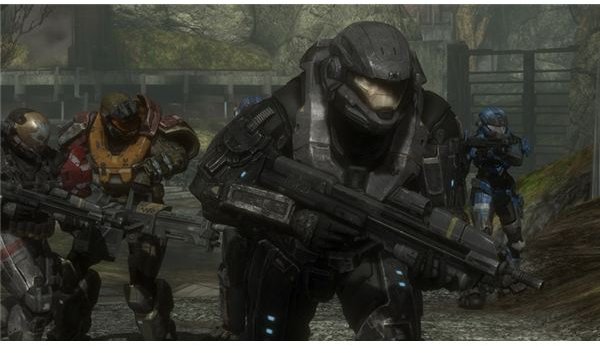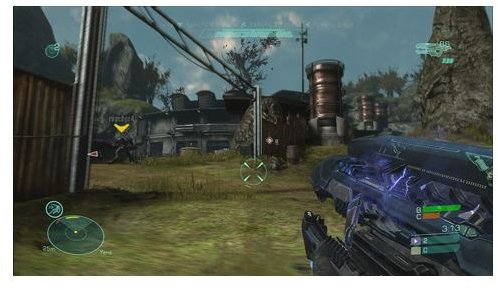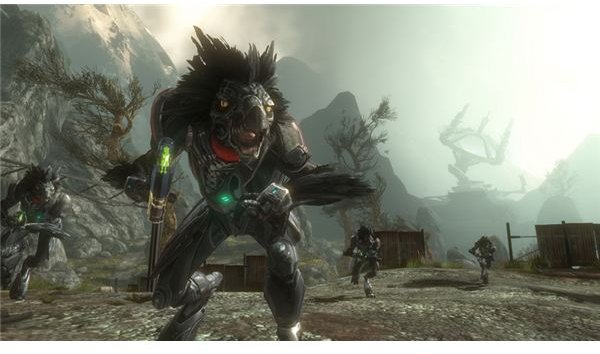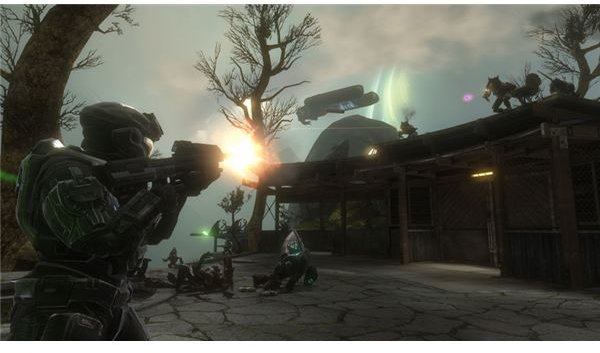Halo: Reach Beta Impressions and Review of New Weapons, Armor Abilities, and Social Settings

Halo: Reach Beta
The biggest thing to hit the Xbox 360 community this week was definitely the introduction of the Halo: Reach Multiplayer Beta. Open to everyone who owns a copy of Halo 3: ODST, along with certain other qualified individuals, the beta has given a select few a taste of the multiplayer mayhem we’ll all be enjoying this fall.
The game technically takes place before the events of the first Halo, but the upgraded weaponry and armor abilities definitely seem to improve over the original series. Some aspects of the game really shine, while others still need a bit of polish. Check out some of our first impressions of the game.
Item Store/Armor Customization

Unlike Halo 3, where custom armor pieces were unlocked by completing certain tasks in the game or, in the case of the much-coveted Scout Armor, by begging the right developer at the right time, the customization options in Halo: Reach are unlocked with credits you earn by playing the game. There are a lot more options available than in Halo 3.
The downside to this system, at least the way it’s currently implemented, is that it can take a very long time to build up enough points to purchase anything. The items seem to start at around 500 credits apiece, and at somewhere around 100 credits a game, you will need to put in some time before you can afford many of the most expensive pieces.
The rank system is also based on the credits you earn, but with the first rank being somewhere above 2,000 credits, and most players only earning somewhere around 100 a game, only the truly dedicate are going to see the upper ranks unless they tweak the system a bit.
Armor Abilities

Adding some much-needed differentiation to the Halo experience is armor abilities. Now, Spartans can choose between four different types of armor: scout, stealth, guardian, and airborne. Each armor type has its own special ability: scouts can sprint for a short period of time, stealth players can utilize active camouflage, guardians can lock their armor, giving them limited invulnerability but also slowing their movement, and airborne soldiers get a jetpack that allows them to fly for short distances.
Elites get armor abilities too, but so far it’s been limited to the jumping dodge move that they employ frequently in the single-player campaign.
These abilities allow a player to customize their loadout to their playstyle. If you’re a flag runner, for instance, then the scout armor is going to be a perfect fit for you. If you’d rather spend your time sniping from a well-concealed, hard to reach position, then the airborne loadout is something you’re sure to enjoy.
These abilities add a little variety to the game, removing the “everyone is the same” aspect of previous games.
Check out page two for more Halo: Reach impressions, including our take on the new weapons, social settings, and the return of health packs.
New Weapons

I haven’t used all the new weapons yet, but the few I have gotten my hands on have really impressed me. The Needle Rifle is an upgraded version of the Covenant Carbine, and it has a much more deadly feel to it. I don’t know if it was the sound it made or what, but the original Carbine always felt more like a water gun than a real weapon to me. The Needle Rifle actually seems to pack a punch.
The Designated Marksman Rifle is the primary weapon in the new SWAT mode, basically team deathmatch with long-range weapons. The DMR is probably my new favorite Halo weapon. It packs the long range punch of the old Battle Rifle, but fires a single round at a time. No more jumping all over the place when trying too zoom in on a target. The DMR is a one-shot headshot killer, and can take down enemies at long range with incredible effectiveness.

The Plasma Repeater is the upgraded version of the Plasma Rifle, and it really packs a punch. What is also packs is the ability to hit the reload button and “vent” the weapon, preventing it from overheating and slowing its rate of fire.
The new Assault Rifle is pretty much worthless at anything but close range. It takes more than a full clip to down an enemy at any type of range, and you’re usually better off closing and delivering a finishing melee blow. It’s better than nothing, for sure, but not by much.
Social Settings

Probably my favorite new feature in Halo: Reach is the ability to tweak your “Social Settings.” Finally, Bungie has delivered an option that allows players to choose the type of people they’re matched up with.
You can tweak settings like how talkative you’d like your teammates to be, whether they’re focused on winning or just having a good time, or how much smack talk you want to endure. This won’t solve all the annoying aspects of playing Halo online, but it’s at least a step in the right direction.
Hopefully my mute button won’t get as much of a workout now that I can at least set some preferences.
Health Packs

Bungie has ditched full regeneration and has chosen to re-introduce health packs to the Halo Universe. I guess it makes sense, this being before the upgrade Master Chief receives in Halo 2, but it will be a bit of an adjustment for some.
Your shields still recharge at the same rate, but your health will remain low until you find one of the health packs scattered around the levels.
Overall, I think the changes Bungie has made to the Halo formula are mostly positive. I absolutely love the armor abilities and most of the new weapons. The playlists are still restricted to four on four matches, and there are only two maps available so far, so I’ll reserve an overall judgement until I get a chance to check out some larger battles and some of the new vehicles.
Still, I think this fall is going to be a good one for fans of multiplayer mayhem.
